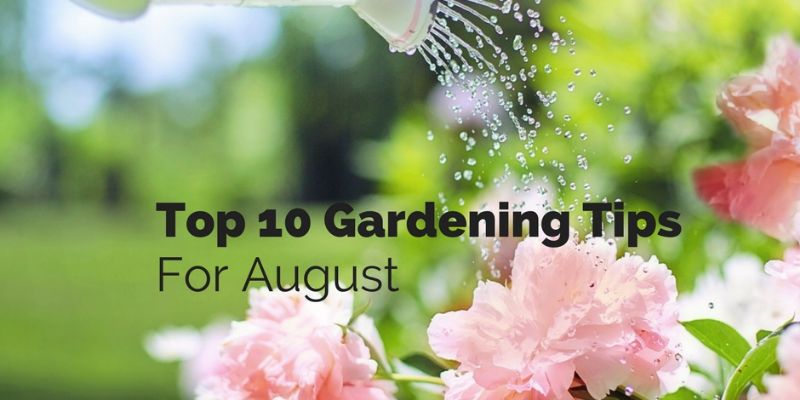Andrew Tokely's Gardening Tips for August
23 June 2020August is usually a busy month bringing in the harvest. But there are still plants and crops to get going in readiness for next years display.

- This month I like to keep a check over any soft succulent leaves on my bedding plants for any signs of Caterpillar damage. Caterpillars can eat the leaves of Nasturtiums and Geraniums to shreds in about two days. Caterpillars love to feed on these leaves and can quickly spoil your plants. If seen in the early stages they can be picked off, and any eggs rubbed off the leaves. If however you get a bad attack, you may need to spray with a suitable insecticide.
- If you have an old strawberry bed that needs regenerating or you want to increase the size of your strawberry bed next year, this is best done during early August. Your old established plants should be producing plenty of runners; these can be pegged down with a wire hoop into pots or trays. These will quickly root and then once rooted; they can be cut away from the mother plants ready for planting your new strawberry bed this autumn. Alternatively you can order new plants from Mail order companies to plant up a new area.
- August is the ideal time to plant Colchicums (misleadingly called the autumn crocus). The attractive flowers of these bulbs appear before its foliage. I always think these look best if planted in grass areas. These bulbs will be available for sale from most good garden centres.
- This month is the time to lift and store early and second early potatoes for future use. I always take my time to carefully fork out the tubers and dry them in the sun for about 1 hour, and then I put them into potato sacks. You can leave main crop potatoes for harvesting early next month. If you have cut the foliage down from your potatoes because they were affected by blight last month, do not lift the tubers for at least three weeks after cutting the foliage down. Otherwise the blight fungal spores could still affect the tubers you store as they are lifted through the soil and ruin your crop.
- All gardeners like to plan ahead, so if you want to grow Hyacinths for Christmas, the ‘Prepared Hyacinth’ bulbs will be on sale in Garden Centres this month. These should be purchased and potted up into containers of bulb fibre as soon as possible. Once potted up place in a cool dark place outside (Covered up with peat against a north-facing wall is ideal). Start inspecting the pots for developing shoots in 6-8 weeks time. When the growth is 2.5cm (1in) high, containers can be moved indoors into cool conditions.
- Often at this time of year many of my early flowering annuals and perennial plants start to look tied or have already finished flowering. I like to cut these back hard or sometimes remove them totally from the borders during the month. Then to ensure there is still colour in the garden, I stand some of my flowering patio containers in their place to fill the gaps and prolong my colourful display.
- Sweet corn will be ready to harvest later this month. An easy way to check if it is ready to eat is when the Silks (tassels) turn brown and the cobs look swollen. Then pull back a little of the sheath around the cob, push your fingernail into one of the kernels, and if a milky juice comes out they are in perfect condition for eating.
- If you have some very good baskets of Trailing Geraniums or Pots of Zonal Geraniums, why not take your own cuttings. Geranium cuttings taken now root very easily. Simply trim off shoots about 2.5 cm (2in) long, and cut just below a pair of leaves. Then remove the bottom pair of leaves and any flower buds. This cutting is now ready, I then like to dip the cut end into Hormone Rooting Powder, this is now ready for inserting into pots or trays filled with moist Multipurpose Compost. Cuttings taken at this time of year root very easily if placed on the bench in a greenhouse or even stood outside in a semi shaded part of the garden (Unlike other cuttings, Geranium cuttings Do Not need covering with polythene to aid rooting). After initial watering, keep trays of compost on the dry side whilst rooting, this will help prevent stem rot (Blackleg) occurring. Plants should be rooted in 14-21 days.
- As space comes available from early harvested crops and where Potatoes were, make sure you fill it up again, as now is a good time to sow some over wintering Japanese Onions. Sown now outside in drills these will quickly germinate and will be ready for thinning early next year as spring onions then I leave the rest to mature as full sized onions for use from June onwards. I find these a useful crop to grow as; you will have onions ready to use just as your stored onions have finished. I think one of the best varieties to grow is Onion Hi Keeper F1 Hybrid.
- For a continuous supply of salad leaves going into the autumn, I will be making another sowing of Mixed salad leaves into pots on the patio this month. These will quickly germinate and produce fresh mixed leaves ready to pick as baby leaves in around 28-30 days. The advantage of sowing these leaves in pots at this time of year is that they can always be moved to a cool glasshouse or sheltered part of the garden if the weather turns bad.